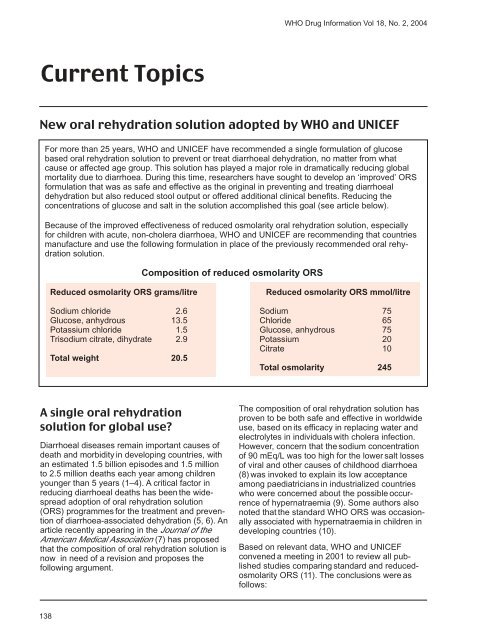WHO Drug Information Vol. 18, No. 2, 2004 - World Health ...
WHO Drug Information Vol. 18, No. 2, 2004 - World Health ...
WHO Drug Information Vol. 18, No. 2, 2004 - World Health ...
Create successful ePaper yourself
Turn your PDF publications into a flip-book with our unique Google optimized e-Paper software.
Current Topics<br />
138<br />
<strong>WHO</strong> <strong>Drug</strong> <strong>Information</strong> <strong>Vol</strong> <strong>18</strong>, <strong>No</strong>. 2, <strong>2004</strong><br />
New oral rehydration solution adopted by <strong>WHO</strong> and UNICEF<br />
For more than 25 years, <strong>WHO</strong> and UNICEF have recommended a single formulation of glucose<br />
based oral rehydration solution to prevent or treat diarrhoeal dehydration, no matter from what<br />
cause or affected age group. This solution has played a major role in dramatically reducing global<br />
mortality due to diarrhoea. During this time, researchers have sought to develop an ‘improved’ ORS<br />
formulation that was as safe and effective as the original in preventing and treating diarrhoeal<br />
dehydration but also reduced stool output or offered additional clinical benefits. Reducing the<br />
concentrations of glucose and salt in the solution accomplished this goal (see article below).<br />
Because of the improved effectiveness of reduced osmolarity oral rehydration solution, especially<br />
for children with acute, non-cholera diarrhoea, <strong>WHO</strong> and UNICEF are recommending that countries<br />
manufacture and use the following formulation in place of the previously recommended oral rehydration<br />
solution.<br />
Composition of reduced osmolarity ORS<br />
Reduced osmolarity ORS grams/litre Reduced osmolarity ORS mmol/litre<br />
Sodium chloride 2.6 Sodium 75<br />
Glucose, anhydrous 13.5 Chloride 65<br />
Potassium chloride 1.5 Glucose, anhydrous 75<br />
Trisodium citrate, dihydrate 2.9 Potassium 20<br />
Citrate 10<br />
Total weight 20.5<br />
Total osmolarity 245<br />
A single oral rehydration<br />
solution for global use?<br />
Diarrhoeal diseases remain important causes of<br />
death and morbidity in developing countries, with<br />
an estimated 1.5 billion episodes and 1.5 million<br />
to 2.5 million deaths each year among children<br />
younger than 5 years (1–4). A critical factor in<br />
reducing diarrhoeal deaths has been the widespread<br />
adoption of oral rehydration solution<br />
(ORS) programmes for the treatment and prevention<br />
of diarrhoea-associated dehydration (5, 6). An<br />
article recently appearing in the Journal of the<br />
American Medical Association (7) has proposed<br />
that the composition of oral rehydration solution is<br />
now in need of a revision and proposes the<br />
following argument.<br />
The composition of oral rehydration solution has<br />
proven to be both safe and effective in worldwide<br />
use, based on its efficacy in replacing water and<br />
electrolytes in individuals with cholera infection.<br />
However, concern that the sodium concentration<br />
of 90 mEq/L was too high for the lower salt losses<br />
of viral and other causes of childhood diarrhoea<br />
(8) was invoked to explain its low acceptance<br />
among paediatricians in industrialized countries<br />
who were concerned about the possible occurrence<br />
of hypernatraemia (9). Some authors also<br />
noted that the standard <strong>WHO</strong> ORS was occasionally<br />
associated with hypernatraemia in children in<br />
developing countries (10).<br />
Based on relevant data, <strong>WHO</strong> and UNICEF<br />
convened a meeting in 2001 to review all published<br />
studies comparing standard and reducedosmolarity<br />
ORS (11). The conclusions were as<br />
follows:

















